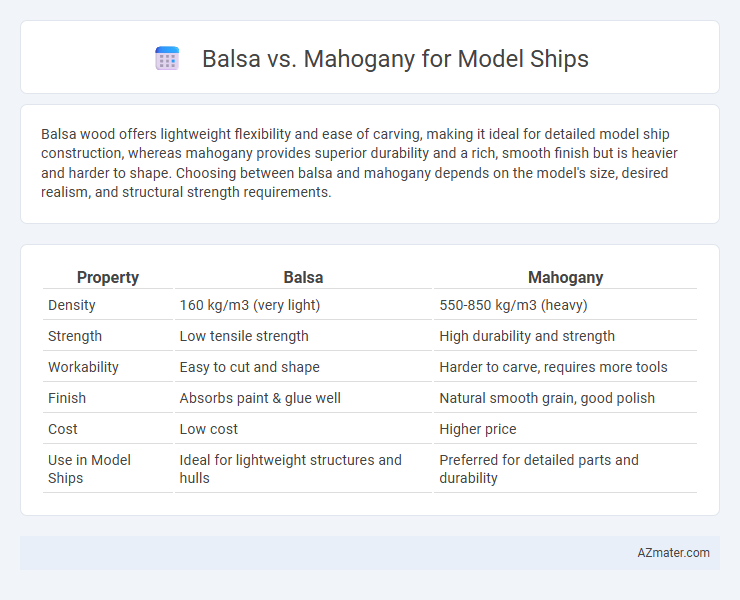Balsa wood offers lightweight flexibility and ease of carving, making it ideal for detailed model ship construction, whereas mahogany provides superior durability and a rich, smooth finish but is heavier and harder to shape. Choosing between balsa and mahogany depends on the model's size, desired realism, and structural strength requirements.
Table of Comparison
| Property | Balsa | Mahogany |
|---|---|---|
| Density | 160 kg/m3 (very light) | 550-850 kg/m3 (heavy) |
| Strength | Low tensile strength | High durability and strength |
| Workability | Easy to cut and shape | Harder to carve, requires more tools |
| Finish | Absorbs paint & glue well | Natural smooth grain, good polish |
| Cost | Low cost | Higher price |
| Use in Model Ships | Ideal for lightweight structures and hulls | Preferred for detailed parts and durability |
Introduction to Model Ship Building Materials
Balsa wood and mahogany are two popular materials used in model ship building due to their unique properties. Balsa is lightweight, easy to carve, and ideal for creating detailed hulls and intricate parts, making it a favorite for beginners and precision work. Mahogany, known for its durability and rich grain, offers strength and a polished finish, often chosen for high-quality, collectible model ships requiring longevity and a classic look.
Overview of Balsa Wood Characteristics
Balsa wood is renowned for its exceptional lightness and softness, making it ideal for model shipbuilding where intricate detailing and ease of shaping are essential. Its low density allows for quick sanding and cutting, facilitating the creation of delicate components, while maintaining sufficient strength for structural elements. Unlike denser woods such as mahogany, balsa offers superior buoyancy and is less likely to add excessive weight, enhancing the model's realism and performance.
Key Properties of Mahogany Wood
Mahogany wood is prized in model shipbuilding for its exceptional durability, fine grain, and rich reddish-brown color, which enhances the aesthetic appeal of intricate ship details. Its high density and strength provide structural stability, making it ideal for parts that require precision and resilience. Unlike balsa, mahogany resists warping and offers superior machining properties, ensuring accurate shaping and long-lasting models.
Weight and Density Comparison: Balsa vs Mahogany
Balsa wood weighs approximately 160 kg/m3, making it one of the lightest woods ideal for model ship construction, while mahogany ranges from 530 to 850 kg/m3, significantly denser and heavier. The low density of balsa provides excellent buoyancy and ease of shaping, whereas mahogany's density contributes to enhanced durability and strength but adds weight that may affect model ship balance. Choosing between balsa and mahogany depends on whether lightweight performance or structural robustness is prioritized in the model ship design.
Workability and Ease of Crafting
Balsa wood offers exceptional workability and ease of crafting due to its lightweight and soft texture, allowing intricate cuts and shaping with minimal effort, making it ideal for beginners in model ship building. Mahogany, while harder and denser, provides greater durability and a smooth finish but requires sharp tools and more experience to carve precisely, posing a moderate challenge for detailed work. Choosing between balsa and mahogany depends on prioritizing ease and speed of crafting versus strength and long-lasting aesthetics in model ship construction.
Strength and Durability Factors
Mahogany offers superior strength and durability compared to balsa, making it ideal for model ships requiring long-lasting structural integrity. Its dense grain resists warping and impacts, providing enhanced stability during handling and display. Balsa is lightweight but significantly less robust, often necessitating additional reinforcement for durable model ship construction.
Authenticity and Appearance in Scale Models
Mahogany offers a rich, deep grain and warm reddish-brown hues that enhance the authenticity and traditional appearance of scale model ships, making it a preferred choice for historical accuracy and detailed finishes. Balsa, known for its lightweight and pale color, often requires staining or painting to achieve a realistic look but provides easier manipulation for intricate parts in model shipbuilding. Choosing mahogany improves the visual depth and durability of the model, while balsa allows for faster assembly and modifications, balancing appearance with construction flexibility.
Cost and Material Availability
Balsa wood is significantly more affordable and widely available in hobby shops and online stores, making it the preferred choice for budget-conscious model shipbuilders. Mahogany, while prized for its durability and rich grain, tends to be more expensive and less accessible due to limited supply and sustainability concerns. Cost-effectiveness and easy procurement of balsa wood make it ideal for beginners, whereas mahogany is favored for high-quality, display-grade models despite higher costs.
Best Applications for Balsa and Mahogany
Balsa wood is ideal for model ship components requiring lightweight construction and easy shaping, such as hulls and intricate decorative elements, due to its low density and excellent workability. Mahogany offers superior strength and durability, making it best suited for structural parts that demand stability and a fine finish, like keel and frames. Using balsa for quick prototyping and mahogany for detailed, lasting models ensures optimal performance and aesthetic quality.
Conclusion: Choosing the Right Wood for Your Model Ship
Balsa wood offers lightweight ease and excellent workability, making it ideal for intricate model ship components and rapid prototyping. Mahogany provides superior durability and rich grain, perfect for high-quality, detailed finishes and long-lasting models. Select balsa for speed and precision in smaller parts, while mahogany suits premium builds requiring strength and a classic aesthetic.

Infographic: Balsa vs Mahogany for Model Ship
 azmater.com
azmater.com